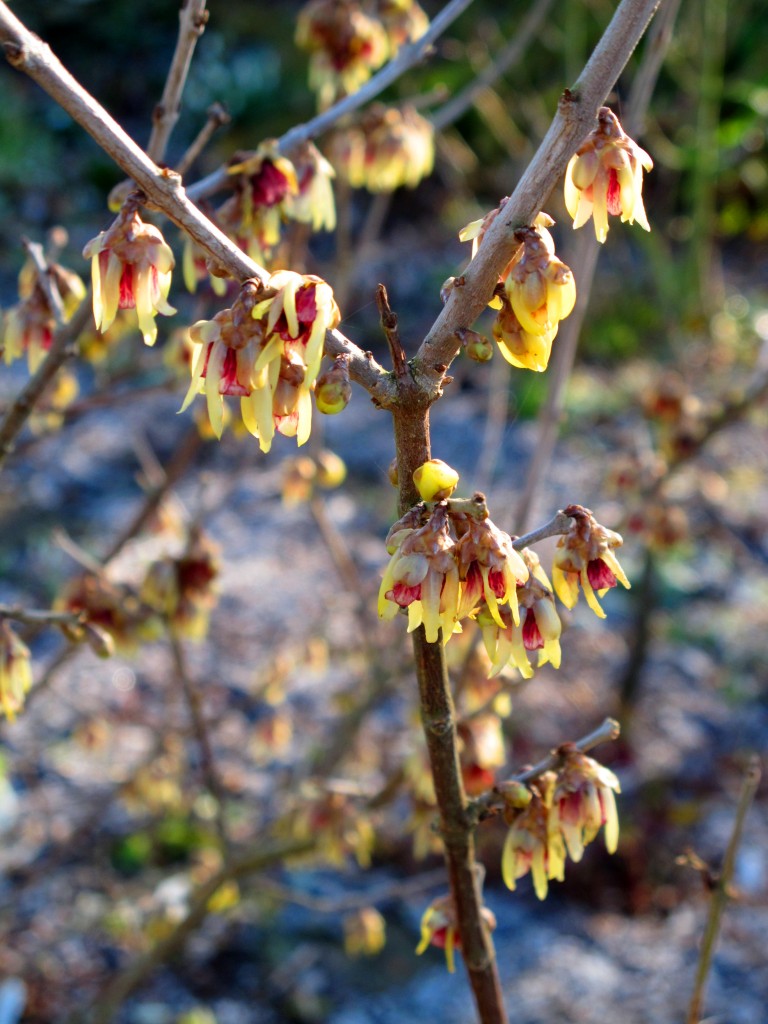It’s cold in Cold Aston, high up in The Cotswolds, and it’s quite possible to get four seasons all in one day throughout the year. And that’s a good reason for having a greenhouse for a sheet of glass between you and the elements can make the world of difference up here. My cold eyrie of a garden means that fragrance, usually prompted by nectar flowing when there’s warmth in the air, is a very hit and miss affair – particularly in winter. The lily-like scent of winter-flowering Daphne bholua ‘Jacqueline Postill’ and the freesia scent of Hamamelis x intermedia ‘Aurora’ evaporate away unless it’s a rare calm and clement winter  afternoon.
afternoon.
Thankfully wintersweet or Japanese allspice, Chimonanthus praecox, manages to deliver a sweet fragrance from its waxy lemon flowers on the chilliest day. I can inhale from a distance and still detect the sweet scent and I can pick the bare, flower studded branches. They last indoors far longer than anything else. and it’s worth the world to me to have some cut flower in the heart of winter. The name even means winter flowering.
It’s a deciduous shrub found at altitude in China, normally 10000 ft (3000m ). However it’s been grown here since 1766 and was first cultivated in the conservatory at Croome Court in Worcestershire, by the 6th Earl of Coventry. A large shrub, it soon outgrew its space under glass and had to be relegated to the garden. Once planted it was found to be far hardier than at first thought. Croome, now managed by The National Trust, was the first large-scale garden to be landscaped by ‘Capability’ Brown, who also designed the Palladian house, so it’s well worth a visit. www.nationaltrust.org.uk/croome
When buying your own chimonanthus, find a flowering plant because the downward-facing flowers come in various shades of yellow. ‘Grandiflorus’ is the earliest to flower and the large deeper-yellow flowers are stained in red. The ordinary species (C. praecox) is more translucent with pallid flowers stained in purplish red staining. It flowered four years after I planted it as a small snippet. ‘Luteus’ is aways later into flower. Once bought, place the pot in a sheltered spot and plant in mid-March – a good tip for all winter purchases.
I planted mine more in hope than anything else eight years ago, for it’s said that chimonanthus needs a warm wall and bright light to flower well. We do get bright light up here, but a warm wall wasn’t an option so it’s in an open spot. However it’s thrived despite that, forming a medium-sized shrub that comes through winter and produces lots of flowers. This year I had quince-like fruits.
The winter flowers are delightful. However the green leaves that follow are uninspiring ( which is code for ugly ) and prone to flea beetle but that’s the price you pay. In fact it’s a real Jekyll and Hyde plant – lovely in winter and horrible in summer. I have to forgive it though, because the winter flowers are magical. In any case we all have a bit of Mr Hyde in our personalities. My dark side escapes when I’m on a telephone help line and Michael Bublé crooning down the line doesn’t help – lovely though he is.
I have more Jekyll and Hyde plants and they include the corkscrew hazel, Corylus avellana ‘Contorta’. In winter light the coiled stems look wonderful against the winter sky as the emerging catkins catch the raindrops like jewels, or shimmy and shake in the wind. When leaves are added though ‘Contorta’ morphs into ‘Congesta’ – a tangle of foliage not helped by the fact that there are always ramrod straight suckers rising up from the ground.
This mad hazel had humble roots. It began life in a Gloucestershire hedgerow at Frocester Court Estate in 1863. The gardener at Frocester passed the oddity on to the gardener of Lord Ducie at Tortworth Court and it was planted there and at Westonbirt Arboretum nearby. However it was Edward Augustus Bowles (1865 – 1954) who popularised it for garden use. He probably received it from his gardening mentor Canon Henry Nicholson Ellacombe (1822–1916) of Bitton, also in Gloucestershire. For Ellacombe was notoriously generous to his prodigy.
Bowles adored quirky plants, including spiky snowdrops, and he developed an area in his Myddelton House garden near Enfield in Middlesex which he called the Lunatic Asylum. Among his ’maniacs’, as he called them, was the contorted hazel and it still grows there today. Colloquially known as Harry Lauder’s Walking Stick, because it’s said that this Scottish music hall star had a walking stick made from twisted hazel, you see it in many gardens.
The twisted hazel is also good to cut in winter and I will almost certainly add another scruff to the vase, the winter-flowering iris or Iris unguicularis. Good named forms include the silver-grey ‘Walter Butt’ and the mid-blue ‘Mary Barnard’. Both will unfurl their flowers within minutes in a warm room and on a winter’s day that’s real Harry Pottter stuff. It was originally collected in Algeria by botanist and bulb lover Dean William Herbert (1778 – 1847), it would make a lovely addition to the sunny side of your greenhouse, although it will need tweaking and regular grooming.
Bowles and Canon Ellacombe both grew this and both agreed that this iris thrived on neglect, once established. They also thought that this plant needed patience because it took several years to give of its best. Gardening and patience go hand in hand but Bowles wrote that “during the dullest months of the year I feel sure no outdoor plant can beat Iris unguicularis.” He hadn’t seen my wintersweet though!



